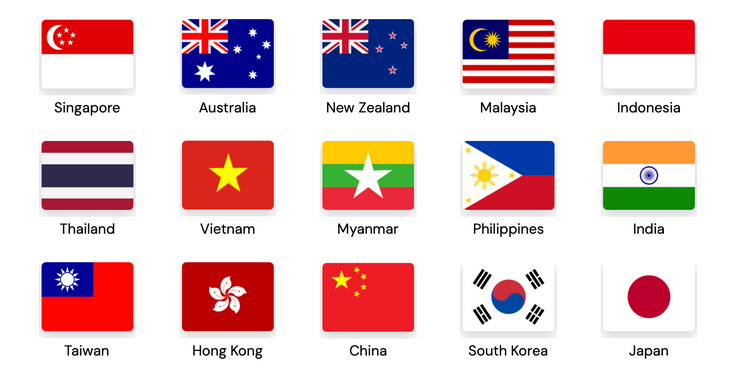As companies continue to expand their presence in the Asia-Pacific (APAC) region, Singapore has emerged as a prime destination for businesses seeking to tap into the thriving Southeast Asian (SEA) market.
With its strategic location, business-friendly environment, political stability, international diplomacy and diverse population, Singapore serves as an ideal gateway to the region.
However, to truly succeed in the ASEAN market, companies must prioritise localization and adapt their products and services to resonate with local consumers and B2B buyers.
The Opportunities in Southeast Asia
Southeast Asia presents a wealth of opportunities for businesses expanding to Singapore.
The region is home to over 650 million people, with a rapidly growing middle class and increasing purchasing power. The digital economy in ASEAN is also booming, with e-commerce, mobile payments, and online services experiencing exponential growth.
By establishing a presence in Singapore, companies can tap into this vast market potential and benefit from the country’s strong economic ties with neighbouring countries.
Understanding the Importance of Localization
While the opportunities in ASEAN are significant, success in this market requires a deep understanding of local cultures, preferences, and behaviours.
Consumers and business people in ASEAN are diverse, with different languages, traditions, and values across countries like Indonesia, Malaysia, Thailand, Vietnam, and the Philippines.
Companies must adapt their products, services, and marketing strategies to effectively engage with these consumers and business people and build lasting relationships to meet local audience expectations.
The Pitfalls of Neglecting Localization
Failing to prioritise localization can lead to costly mistakes and missed opportunities for companies expanding to Singapore and targeting the ASEAN market. Some common pitfalls include:
1. Assuming a one-size-fits-all approach
Our clients repeatedly try to make one app that suits all. In our experience, this doesn’t always work.
What works in one market may not necessarily translate to success in another. Companies that fail to adapt their offerings to local preferences risk alienating consumers and struggling to gain market share. Regardless of the politics in your MNC, if you want to succeed, you must test your products with locals and adapt accordingly.
In most of Southeast Asia, the widespread adoption of mobile technologies has made the internet predominantly accessible through mobile devices, shaping product designs to be mobile-centric.
This trend significantly influences e-commerce, where a high percentage of users interact through mobile platforms, leading to a focus on mobile-friendly business strategies. These developments necessitate adjustments in e-commerce logistics and services to cater to the mobile-first consumer base.
In our recent client experiences, we have conducted research and contributed to the development of mobile-centric solutions.
For Maya, a digital payments banking app in the Philippines, we discovered that users preferred to top up their digital wallets in sari-sari stores (convenient stores) for online payments. Additionally, we assisted UOB in localising their mobile-only banking app, TMRW for the Thailand and Indonesia markets.
These projects underscore the importance of understanding local market dynamics and consumer behaviours to deliver tailored, mobile-first solutions in Southeast Asia’s e-commerce landscape. You can read more about Asia’s mobile economy in GSMA’s report and the State of Asia’s Mobile Internet Connectivity here.
2. Overlooking language differences
ASEAN is home to a wide range of languages, including Bahasa Indonesia, Thai, Vietnamese, and Tagalog. Neglecting to communicate with consumers in their preferred language can lead to complete adoption failure.
When conducting UX testing in ASEAN countries, it is crucial to engage with local language participants in their native language.
Instead of having the facilitator conduct the testing in English and relying on a translator for the participant, it is more effective to have a facilitator who is fluent in the local language and can directly communicate with the participants.
This approach ensures that the nuances and subtleties of the language are not lost in translation, allowing for more accurate and meaningful feedback from the participants.
By conducting UX testing in the local language, researchers can gain a deeper understanding of the participants’ thoughts, feelings, and experiences, as they are able to express themselves more naturally and comfortably in their native tongue.
A notable case study illustrating the importance of addressing language differences in marketing is the HSBC “Assume Nothing” campaign.
Originally intended to promote the bank’s services globally, the slogan “Assume Nothing” was misinterpreted in various international markets as “Do Nothing.”
This miscommunication negatively impacted the brand’s message and customer engagement, leading to a costly rebranding effort. HSBC had to spend $10 million to change its slogan to “The World’s Private Bank” to recover from this blunder and regain client trust (Speakt.com) (Business News Daily). This case underscores the critical need for accurate translation and cultural sensitivity in global marketing strategies.
3. Ignoring cultural nuances
From colour symbolism to social norms, cultural nuances play a significant role in shaping consumer behaviour in SEA. Companies that fail to consider these nuances in their product design and marketing risk offending or alienating potential customers.
Localization involves careful adaptation of marketing materials to meet the local preferences and cultural standards of each market. This can include altering images, colours, and designs that may be interpreted differently across cultures.
Localisation also encompasses the use of local dialects and colloquialisms to ensure that marketing messages are not only understood but also well-received.
Example: McDonald’s “I’m lovin’ it” slogan – Modified to fit different languages – less acceptable in countries like China or Spain, where the word “love” carries a much heavier connotation. Instead, “I’m lovin’ it” became “Me Encanta” (Spanish for “I really like it”) and “我就喜欢” (Chinese phrase with a similar meaning to “I like it no matter what you say)

4. Underestimating the importance of local research
Conducting thorough user research and engaging with local users is crucial for understanding the unique needs, preferences, and pain points of ASEAN audiences. Skipping this step can result in products that miss the mark and fail to gain traction.
Partnering with Localization Experts

To overcome these challenges and successfully navigate the ASEAN market, companies expanding to Singapore should consider partnering with localization experts who have deep knowledge of the region.
These experts can provide valuable insights into local cultures, conduct research with target audiences, and help adapt products and services for maximum impact.
Conclusion
Research Network, a leading recruitment and research management service provider across APAC, specialises in helping companies confidently localise their offerings for cultural relevance. With a team of local experts, moderators, and translators across 15 regional countries, Research Network offers comprehensive support for businesses looking to unlock success in ASEAN.
Confidently launch your product in ASEAN. By leveraging Research Network’s expertise in localization and market research, companies you can:
1. Gain deep insights into local consumer preferences and behaviours
2. Adapt products and services to resonate with ASEAN audiences
3. Conduct user testing and validation with local consumers
4. Develop culturally relevant marketing and communication strategies
5. Build strong, lasting relationships with ASEAN customers
As companies shift their focus to Singapore and the ASEAN market, prioritising localization is key to unlocking success in this dynamic and diverse region.
By partnering with experienced localization experts like Research Network, businesses can navigate the complexities of the ASEAN market, avoid costly mistakes, and develop products and services that truly resonate with local consumers.
With the right approach and a commitment to understanding local cultures and preferences, companies can tap into the vast potential of Southeast Asia and build a strong, sustainable presence in this exciting market.
Research Network is a user Testing Recruitment Agency based in Singapore with APAC-wide capability. We have a diverse panel of high-quality participants. We can recruit for both consumer and business testing across all demographics and industries.


